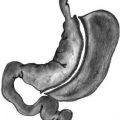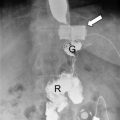Fig. 5.1
shows gastric pouch (white arrow) and short proximal, blind-ending afferent jejunal limb (black arrow)
The stomach is divided and there is a band of staples which occludes the proximal stomach. The proximal retrained gastric pouch has a volume of approximately 20–30 mL.
The jejunum is divided approximately 30–40 cm distal from the ligament of Treitz, and a side-to-side gastro-jejunostomy is performed with the proximal gastric pouch. As a result of the side-to-side anastomosis, a small afferent, “blind” loop is left in situ.
A distal jejuno-jejunal anastomosis is created approximately 100–150 cm distal to the proximal gastro-jejunostomy. This procedure provides a combination of both restriction and malabsorption. Early complications include anastomotic leaks from one of the two surgical anastomosis, i.e. from the gastro-jejunal anastomosis or the jejuno-jejunal anastomosis. Leaks can also occur from the two staple lines at the divided stomach or the short, blind ending of the afferent jejunal limb. Late complications include small bowel obstruction and marginal ulcer formation. The risk of complications increases in those patients who have had previous failed bariatric surgery such as a laparoscopic band where there may be fibrosis or scarring around the gastric fundus.
Common complications of the Roux-en-Y gastric bypass procedure are as follows [4–10]:
Intestinal hernias (incisional or internal) in 6–17% of cases
G-J or J-J anastomotic strictures in 3–9%
Anastomotic leak in 3–9%
Small bowel obstruction in 1–5%
Marginal ulceration in 0.5–13%
Contrast studies with CT and/or fluorosopy have been shown to have a sensitivity and specificity of around 50% in the diagnosis of complications following bariatric surgery. Routine postoperative imaging has not been shown to be of significant value [2–5] in improving patient outcome.
Postoperative complications are best demonstrated by a combination of CT and/or oral contrast studies. One of the most common and potentially fatal complications is that of a postoperative leak which occurred in 5.3% of cases in a series of 906 patients who underwent Rouxen-Y gastric bypass surgery of which 77% occurred at the gastro-jejunal anastomosis (Fig. 5.2 a, b) [7].


Fig. 5.2
(a and b) Axial and coronal views showing gas and fluid (arrows) from leak at G-J anastomosis
Contained leaks can be treated by percutaneous catheter drainage, whereas larger leaks with clinical signs of peritonitis will require open or laparoscopic surgery with a peritoneal washout together with repair of the leak and placement of a surgical drain.
Small bowel obstruction may occur as a result of stricture formation at the distal jejuno-jejunal anastomosis or by internal herniation (Fig. 5.3a, b) through the mesocolic window via the roux loop (Petersen’s space). Diagnosis is often difficult and may require a combination of barium follow through studies and CT scanning and occasionally can only be determined by way of laparotomy. Patients present with typical symptoms of small bowel obstruction.


Fig. 5.3
(a) Abdominal X-ray showing proximal small bowel obstruction with dilated jejunal loops in the upper left side of the abdomen. (b) Corresponding CT scan showing dilated, fluid-filled loops of jejunum (blue arrow) on the left side of the abdomen lateral to the descending colon (white arrow)
Normal appearance of end-to-side gastro-jejunal anastomosis (Fig. 5.4a) with short blind-ending afferent loop (arrow).


Fig. 5.4
(a) Normal appearance of end-to-side gastro-jejunal anastomosis with short blind-ending afferent loop (arrow). (b and c) Excessively formed long afferent jejunal loop (arrows)
A rare complication which can result in persistent gastro-oesophageal reflux and vomiting is due to a long afferent proximal blind-ending jejunal loop, the so-called “candy cane” or “hockey stick” appearance (Fig. 5.4b and c).
Strictures at the gastro-jejunal anastomosis are due to the presence of fibrosis and patients present with reflux and vomiting which can be treated by endoscopic dilatation. They tend to appear in the later stages after surgery and have been reported in up to 9% of cases [8] (Fig. 5.5).


Fig. 5.5
Gastro-jejunal stricture (arrow) post-RYGB
5.1 Ulceration at the Gastro-Jejunal Anastomosis
Patients present with epigastric pain and bleeding Treatment is usually conservative with appropriate proton pump inhibitors (Fig. 5.6).


Fig. 5.6
(a and b) shows a large marginal ulcer (arrow)
Ulceration and oedema can also rarely develop in the more distal jejunum, usually as a result of ischaemic damage to the mucosa.
5.2 Laparoscopic Adjustable Gastric Banding (LAGB)
This procedure provides restriction only and is more commonly used for patients with less severe obesity.
Early complications are usually a direct result of the surgery such as ileus or haemorrhage.
There are multiple late complications which can occur, the commonest of which is due to pouch dilatation which occurs in 3–10% of patients and band slippage in up to 13% of patients.
The reported long-term results of LAGB are not as good as LAPG or sleeve gastrectomy with a 3-year failure rate reported to be up to 40%.
5.3 Pouch Dilatation
This complication occurs due to a combination of overeating in the presence of a tight band. The patient can usually be adequately treated without resort to surgery by full or partial deflation of the band under fluoroscopic guidance. Patients may present with acid reflux and waterbrash which is usually worse when lying down at night or with a failure to lose weight as the dilated gastric pouch acts as a reservoir for undigested food.
Barium study show showing a persistently dilated gastric pouch (arrow) pre- (Fig 5.7a) and post-band (Fig. 5.7b) deflation.


Fig. 5.7
Barium study show showing a persistently dilated gastric pouch (arrow) pre- (a) and post-band (b) deflation
Pouch dilatation can progress to band slippage and increasing pouch dilatation. This can be diagnosed by demonstrating a transverse lie of the band on plain abdominal X-ray (Fig. 5.8) and a large overhanging pouch on barium studies (Fig. 5.9).



Fig. 5.8
shows a transversely lying band due to band slippage

Fig. 5.9
showing a large, fluid-filled proximal gastric pouch which overhangs the band
CT scanning can also demonstrate a slipped band (Fig. 5.10a and b), but this is not usually performed unless there are other worrying symptoms present.








